I always tell people that competition is a good thing.
Why?
Because NO competition means there are NO customers.
But there is a tipping point… You may need to change the way you promote and sell your products and services.
There’s a point where there’s SO much competition that even GREAT products fail to attract new customers.
As a result, it gets harder and harder to stand out.
But don’t worry… If your niche or industry reaches that point, not all is lost. You just need to change the way you promote and sell your products and services.
But change HOW?
First, you’ll need to understand the real problem with “too much” competition. Then you can look at the right way to address it.
So, what happens when more and more competitors enter your niche?
The Real Problem With More and More Competition
There is one key concept you need to understand if you want more sales in an overcrowded niche:
Market Sophistication.
Eugene Schwartz first wrote about this idea in his book Breakthrough Advertising.
Here’s what it means:
As more competitors start selling what you sell, customers get bombarded with the same message. The same promises. The same offers.
And what happens?
People get JADED.
When everything starts to sound the same, people tune out. Why? Because there’s only ONE RULE when it comes to being memorable:
What blends in gets ignored. What stands out gets remembered.
So what’s the solution? How do you stand out?
The first step is to understand at what stage of market sophistication you’re in. Only then can you present your offer in the right way…
…aka so you won’t be ignored!
The 5 Stages of Market Sophistication: Which One Are You In?
Here’s what you need to do:
- Look at your competitors and figure out at what stage of “sophistication” your product or niche is in.
- Then come up with the right way to stand out.
This will help you craft your message so that people will remember.
Now, Schwartz laid out 5 specific stages. So, let’s break them down. I’ll share examples and what you need to do in each stage.
We’ll start with…
Stage 1: “Blank Canvas”
I call this first stage the “Blank Canvas” stage. It’s rare that you’ll find yourself here. But it’s a beautiful place to be.
“Blank Canvas” means your niche is WIDE open. You’re selling a type of product no one’s ever heard of before.
Now, this can be tricky, too. If people don’t understand what you sell and – most importantly – what it can do for them, your message will be ignored.
That’s why in this first stage, it’s best to be very DIRECT.
No need to be clever. No need to overcomplicate your message. Just tell it like it is.
As an example:
Let’s say you’re the first to sell a revolutionary new product known as “WATER.”
Ridiculous, I know.
But how do you pitch it in Stage 1?
Easy. You say…
“Stop Thirst! Drink Water Now!”
(We’ll take the this hypothetical “water” example and update it for each stage of sophistication, so you can see the progression.)
Early weight-loss ads are another classic example of the “Blank Canvas” stage. All they needed to say was:
“Lose Ugly Fat Now!”
But that wouldn’t fly in today’s fitness industry…
Sure, people still want to “lose ugly fat” but they’ve heard that claim a million times. So you’ll need a different approach.
Now…
No matter what business you’re in, it’s pretty UNLIKELY you’ll find yourself in Stage 1. So let’s not waste too much time here…
Let’s move on to the next stage.
Stage 2: “Bigger, Better, Faster”
Here’s what happens in Stage 2:
Competitors start entering your niche.
This means customers will hear the same claim over and over again.
As a result, marketers start making bigger, bolder promises in an attempt to outbid the competition.
So that’s what you do in Stage 2: You pile on the features. You make a bolder promise. You claim that your product is bigger, better, faster.
A Stage 2 pitch for water would sound something like this:
“Just One Glass of This Delicious Water Will Immediately Quench Your Thirst”
So, in Stage 2 you simply claim that YOUR “water” is better than “regular water:” You need “Only 1 Glass” and it will quench thirst “Immediately.”
Do you notice how that’s just a bolder version of the “Stop Thirst!” claim from Stage 1?
Or if we’re talking weight-loss…
In Stage 2 it’s not enough anymore to say, “Lose Weight.” Now you need to up your claim. Now it’s “Lose 10 pounds in just 7 days!”
Let me show you a couple of real-world examples.
Example:
Take this book on reading faster…
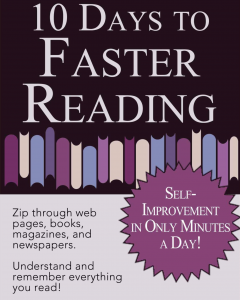
Stage 2: “10 Days to Faster Reading”
The claim is not just “Learn How to Read Fast.”
That might work in Stage 1. But not in Stage 2…
The claim now is much bolder:
You’ll read faster and it only takes “10 Days.” You only have to practice a few “minutes a day.” AND you’ll “remember everything you read.”
Do you see the progression?
Here’s another example…
Example:
“More Pixels than the Human Eye Can Perceive.”
That was Apple’s claim when they introduced the Retina display:
Stage 2: The Retina Display
Now Apple was smarter than just claiming “more pixels” because… who cares?
By calling their new display the “Retina display” Apple essentially created a new type of product. A display so clear you can’t tell it’s a screen.
With that said, the basic claim was still: “Our screen has more pixels.”
That’s typical for Stage 2.
But let me show you one more example.
Example:
Another way to up your claim is an extraordinary guarantee. For example, take the Domino’s Pizza’s “30 min. Delivery Guarantee:”
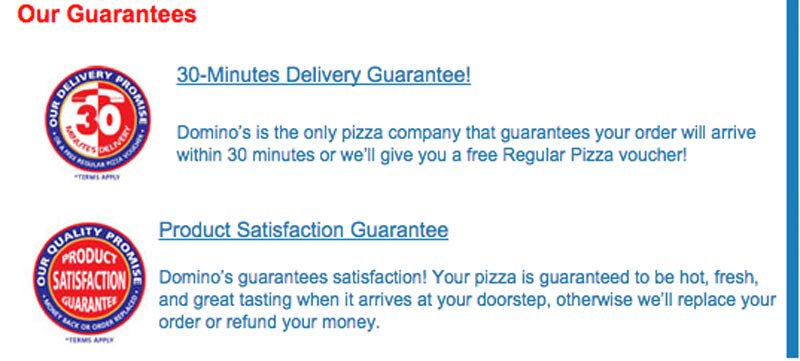
Stage 2: Domino’s 30 Min. Guarantee
Guarantees are often overlooked…
But they can be a GREAT way to set your product apart from the competition. Check out my in-depth guide to crafting persuasive guarantees.
So that’s Stage 2: Bigger, better, faster.
This happens naturally because it’s the obvious reaction to more competition.
And you know what?
Making bold claims works… for a while. It works until the claims get so ridiculous people start calling B.S!
So what if your competitors are already making overblown claims?
Making an even more ridiculous claim would be dumb.
But what then?
Stage 3: “Secret Mechanism”
Welcome to Market Sophistication Stage 3!
Exaggerated claims don’t work any longer…
Because customers don’t believe them anymore. People are already TOO JADED. They’re sick of the hyperbole. That’s why you need something new and different.
You see, in Stage 2 it was enough to make a bold claim. But now…
You have to back it up.
More specifically, you have to give an intriguing and reasonable EXPLANATION of how you’re going to deliver on your promise.
Let’s look at our water example again. We went from “Stop thirst!” (Stage 1) to “Stop thirst faster!” (Stage 2).
And now?
“Quench Your Thirst Faster… With Triple-Purified Water”
We’re introducing a new, secret “mechanism.”
The water is now “triple-purified.”
Do you see how it works?
Many niches are in Stage 3.
Which means, it’s likely you’ll have to find your own hidden mechanism, a new method, or secret process to make your message effective and memorable again.
But let’s be clear:
This isn’t easy.
So let me show you some examples. It will be helpful if you’re trying to stand out in a Stage 3 market.
Let me warn you, though:
Don’t copy what you see here – that would completely defeat the purpose! You’ll have to find your own “secret mechanism.”
With that said…
Do you remember the “10 Days to Faster Reading” book?
Well here’s what the same promise looks like in Stage 3.
Example:

Stage 3: “Speed Reading with the Right Brain.”
This is a very different message than a hyped-up claim like “Read 100x Faster.” And in a Stage 3 market – where everyone else is already making outrageous claims – it’s WAY more effective.
Why? Because it’s more INTRIGUING.
You see, someone who’s interested in “speed reading” might have bought the “Read 100x Faster” product. And maybe it didn’t work as well as that seller promised.
Now imagine if you come along and promise “Read 200x Faster.”
Guess what will happen!
That’s right…
That person will laugh at you and say that you’re full of it.
BUT if you say “Speed Reading with the Right Brain”…
They’ll once again be intrigued.
They’ll think, “Aha! I must have been trying to speed-read with my LEFT brain and that’s why it didn’t work!”
Okay, maybe this is a silly example. I don’t know anything about speed-reading…
But do you see how the “secret mechanism” works?
Let’s look at another product.
Example:

Stage 3: “Learn German With Mnemonics”
This is a resource for learning German.
The message? It’s not “Speak German Fluently In 2 Days” or something silly like that…
Instead, it’s “Learn German with Mnemonics.”
Now that’s more intriguing, isn’t it?
Next, an example from my own business…
Example:
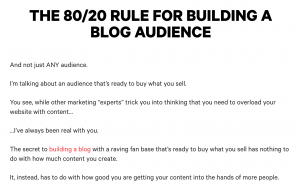
Stage 3: “The 80/20 Rule for Building a Blog Audience”
The 80/20 Rule for Building a Blog Audience is the secret “mechanism” for one of my flagship courses, Blog that Converts.
You see, there’s lots of blogging advice. And pretty much everyone else is saying “You need to create more content to get more traffic.”
But I say, “You can create LESS content and get more traffic… by spending 80% of your time on promotion.”
Then inside the course, I teach people how to do it – and it works like a charm.
All I did was apply the 80/20 Rule to blogging… and made it my “secret mechanism.”
Finally, an example from the fitness world…
Example:
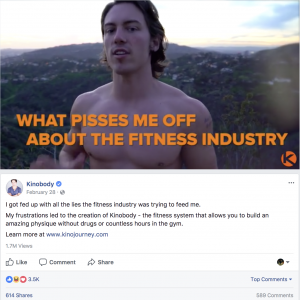
Stage 3: Kinobody
What do you notice?
It’s not just another diet or workout plan… It’s a new “system” that works “without drugs” or “countless hours in the gym.”
This is important. A new system, method, mechanism, or framework is always more powerful than an exaggerated claim by itself.
Can you introduce your own?
I’m sure you can…
And when you do, make sure that you NAME IT!
Because when you give it a name, you put YOUR stamp on it.
Here are some examples:
- The Drafting Technique for getting major press
- Apple’s “Retina display” (see example above)
- Sally Hogshead’s Fascination Personality Test
Let’s move on to the next stage…
What do you do when you’re faced with tough competition, each with their own secret mechanism?
Stage 4: “Bells and Whistles”
Well, you’ve officially entered the “Bells and Whistles” stage.
In this stage, our hypothetical pitch for water becomes…
“Better than Regular Water: Triple-Purified, Vitamin-Enriched, and Extra Refreshing”
It might feel familiar because here’s what happens:
Just like in Stage 2 (“Bigger, Better, Faster”) everyone’s starting to PILE ON the features. And again, things tend to get a little crazy. I mean, just look at this:
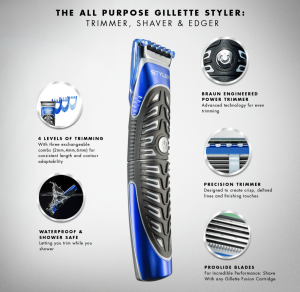
Stage 4: The All Purpose Gillette Styler
This electric razor is “waterproof,” has a “precision trimmer”, “ProGlide blades,” and more. So now there’s not just one special feature or “secret mechanism”…
THERE ARE FIVE!
Kind of ridiculous, right?
Sure, you can go this route and embellish your product with more and more features… But I believe there’s a better strategy.
In fact, I believe there are 2 ways to avoid this features-arms-race:
- “Zig when others zag”
- Go head-to-head
First, “Zig when others zag” simply means:
Look at what everyone else is doing and then…
…do the OPPOSITE.
This is one of the 7 secrets of wildly successful entrepreneurs.
For example, compare the following razor to the Gillette razor above…
Example:
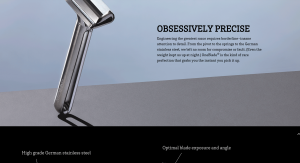
Stage 4: One Blade razor
Clearly, this is a different kind of razor.
Instead of piling on features, this company REMOVED all the features. What they were left with is an “obsessively precise” razor with just “One Blade.”
This is the power of contrast in full effect.
When everyone is selling razors with 17 blades, a razor with just 1 blade is sure to stand out.. Remember…
What blends in gets ignored. What stands out gets remembered.
Just like this old-school Volkswagen ad…
Example:
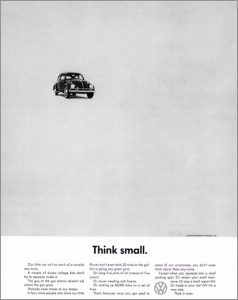
Stage 4: Volkswagen “Think Small”
This ad was ranked as the best ad of the 20th century.
It is pretty genius.
You see, cars back then (1959) were big, bulky, and mostly seen as a luxury. But the VW campaign turned that upside-down.
They focused on the simplicity of the Beetle car and highlighted the advantages of owning a small car – they zigged when everyone else was zagging.
Now…
Your second option is to go “head-to-head” with your competition.
Have you ever seen a comparison table like this?
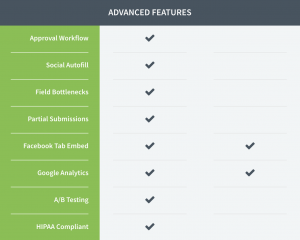
Stage 4: Go head to head…
Software companies often do this to show how their product is better than the competition. If you are trapped in the features-arms-race, this is an effective way to go head-to-head.
Probably the best-known campaign that does this was Apple’s Mac Vs. PC. You’ve probably seen at least one of them:
Example:
Each of the ads focused on a specific feature. For example, one talks about Mac’s MagSafe power connectors. PC is sitting there, banged up in a wheelchair because someone tripped over its cord. Mac goes on to explain that that could never happen with the MagSafe connector because it’s magnetic.
Another example…
Example:
Saddleback Leather made a hilarious video about “How to Knock Off a Bag.” Again, facing the “competition” head-on.
If you’re in Stage 4, you’re already facing some FIERCE competition. But what if adding more “bells and whistles,” or going head-to-head with your competitors doesn’t work?
Uh-oh 😱
But don’t worry. I got you covered.
Stage 5: “Identity”
You’ve reached the highest stage of market sophistication.
Congrats!
Or maybe condolences are more appropriate since this is the toughest stage…
You see, outrageous claims and “secret mechanisms” don’t cut it anymore – no matter how long your list of features and benefits is.
In fact, it’s no longer about your product at all.
Then again, it was never about your product in the first place…
If you want people to care, your message must ALWAYS be about what your product can do for them (“Lose Ugly Fat!”).
In the “Identity” stage this means…
Your product helps people reinforce who they are.. or who they want to be.
Let’s take our water example.
Yeah yeah…Our triple-filtered, vitamin-enriched water kills thirst like no other beverage. But the message is now:
“Drink Water. Save Lives!”
…because “with every bottle sold, we build a well in the third-world.”
(Ignore for a moment that, while a good cause, the whole “we donate when you buy” thing is played out.)
Who buys this water? Good people who want to save lives, of course! Do you see how this reinforces the self-image people have?
Now, most people don’t view themselves as evil. So this “be a good person and save a life when you buy a bottle of water” is much too vague…
You need to dig deeper into people’s identities.
Let’s take a look at some examples.
Example:
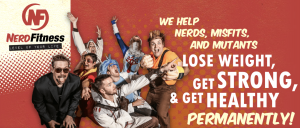
Stage 5: Nerd Fitness
Competition in the fitness industry is FIERCE.
But Nerd Fitness by my friend Steve Kamb is a PERFECT example of how to survive – and thrive – in such an overcrowded niche.
You see, I’m sure it’s a great program. But that’s not why it’s successful…
It’s successful because people see “Nerd Fitness” and think, “Hey, I’m a Nerd! This is the fitness-training for ME!”
Out of a million fitness programs, these people will always choose Nerd Fitness.
Why?
Because it matches AND it reinforces their identity.
Another example…
Example:
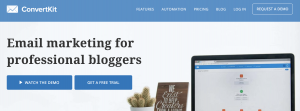
Stage 5: ConvertKit – Email Marketing for Professional Bloggers
ConvertKit’s message doesn’t start with “we’re the best email marketing software.”
No. It’s “Email marketing for professional bloggers.”
In stage 5, you still need a good product. It still helps to have a unique “mechanism.” But it might not be enough…
That’s when “identity” comes into play.
You see this often with big brands, of course…
Example:
In this Calvin Klein ad, there’s…
- Not a word about the actual fragrance.
- Not a word about how it’s made.
- Not a word about how it smells better any other perfume.
But If you’re a FATHER…
…it speaks directly to your identity.
Because clearly, this ad is made to appeal to Dads.
Okay, this was a big brand example. But it doesn’t mean you have to be a big brand to do this. If you’re in a crazy-competitive niche, stop thinking “features and benefits.”
Instead, think about what defines your customer’s identity:
Do they see themselves as nerds?
Professional bloggers?
Dads?
It’s your call. But you need to do the research to figure it out.
That’s how you’ll succeed when your niche reaches the highest level of sophistication.
So… What Stage of Sophistication Are You In?
I know I covered a lot here.
So let’s recap. Let’s look at the progression of our imaginary “water” product:
Stage 1:
“Stop Thirst! Drink Water Now!”
Stage 2:
“Just One Glass of This Water Will Immediately Quench Your Thirst”
Stage 3:
“Quench Your Thirst Faster With Our Triple-Purified Water”
Stage 4:
“Better than Regular Water: Triple-Purified, Vitamin-Enriched, Extra Refreshing”
Stage 5:
“Drink Water. Save Lives!”
The lines between the different stages can get blurry.
So, it’s less about knowing exactly what stage your niche is in. Rather, you need to understand how the psychology works in each stage. Then, you can look at your competition, and make the right move.
And of course, you can COMBINE these ideas…
Make a bolder claim. But back it up with a “secret mechanism” and other unique features. And then, package it all in a way that appeals to the identity of the audience you want to reach.
Easier said than done – I know.
But, this kind of work pays off.
Trust me, if you get it right, you’ll reap massive benefits.
Best of all, you’ll never have to worry about your competition again!
Was this helpful?
If you like this post, please do me a favor:
Do you have a friend or colleague that needs to learn about market sophistication? Maybe they’re starting a new business. Maybe they’re planning a launch. Maybe they’ve been struggling to get their message out…
If you think they need help, please share this post with them now.








Thank you! I’ve been trying to figure out exactly where my niche lies and reading this has brought it into focus for me. Great read. Great information.